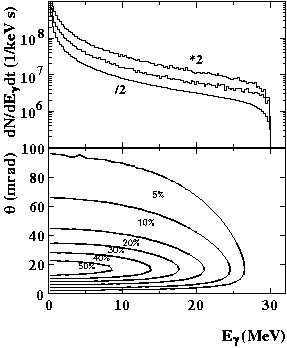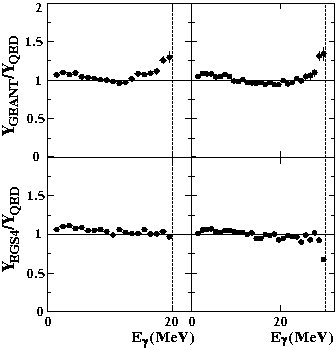|
One area of research of the new ELBE facility at the FZR
will be devoted to nuclear spectroscopy studies
by means of nuclear resonance fluorescence
experiments using polarized photons and
by means of photon-induced fission producing radioactive
nuclei of interest.
For these experiments detailed knowledge about the spectral
distribution of photons from Bremsstrahlung production is
mandatory.
Therefore, three different approaches to determine the spectral
distribution of photons emerging from a thin foil irradiated with
electrons have been taken.
Two calculations are based on Monte-Carlo simulations with commonly
available software packages, GEANT [1] and EGS4 [2], and the third
one is based on an analytical treatment in a quantum electrodynamics
(QED) approach as described by Itzykson and Zuber [3].
Only the QED approach gives a result for the polarization of
photons.
All calculations have been done for 20 MeV and 30 MeV incident
electron energy using a radiator thickness of 20 mm
in the Monte-Carlo calculations.
The QED spectrum has been scaled arbitrarily to match
at 50% of the maximum photon energy.
In order to limit the time needed for the
simulations the low energy cutoff for the propagation of
particles and photons in GEANT is set to 100 keV whereas
it is set to 1.5 MeV for electrons and 100 keV for positrons
and photons in the EGS4 calculations.
Generally, the agreement between the different calculations
is quite good and deviations mainly show up in the
high-energy part of the spectra.
Nevertheless, as shown in Fig. 2, EGS4 gives a better
agreement to the QED calculations for photon energies close
to the end-point as compared to GEANT.
The GEANT calculation overestimates the spectra by at least
10% for the upper 10% of the spectra.
The slight relative enhancement of both Monte-Carlo spectra for the
low-energy part as shown in Fig. 2 indicates the influence
of absorption inside the radiator which are neglected by the
analytical treatment.
|
Fig. 1
Upper part:
Bremsstrahlung photon spectrum for a 20mm Aluminum
radiator and
incident electron energy of 30 MeV calculated
by GEANT (middle), EGS4 (upper, multiplied by factor of 2),
and QED (lower, divided by factor of 2).
Lower part:
Degree of polarization of Bremsstrahlung photons as function
of photon energy and polar angle of observation for
incident electrons of 30 MeV (QED).
|
Fig. 2
Energy dependence of the ratio of bremsstrahlung-spectra from
GEANT (upper row) to the QED calculation and EGS4 (lower row)
to the QED calculation for incident electron energies of
20 MeV (left column) and 30 MeV (right column).
|
References
[1]CERN Program Library Long Writeup Q121, CERN, Geneva (CH), 1994
[2] The EGS4 code system, SLAC-R-265, UC-32, Stanford University
[3] C. Itzykson, J.-B. Zuber: Quantum Field Theory, McGraw-Hill, 1988
IKH
05/28/01
© A. Wagner
|

